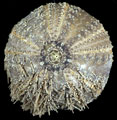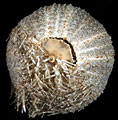The Echinoid Directory
Salmacopsis Doderlein, 1885, p. 93
| Diagnostic Features |
|
|---|---|
| Distribution | Recent; Japan. |
| Name gender | feminine |
| Type | Salmacopsis olivacea Doderlein, 1885, by original designation. |
| Species Included |
|
| Classification and/or Status |
|
| Remarks |
|



